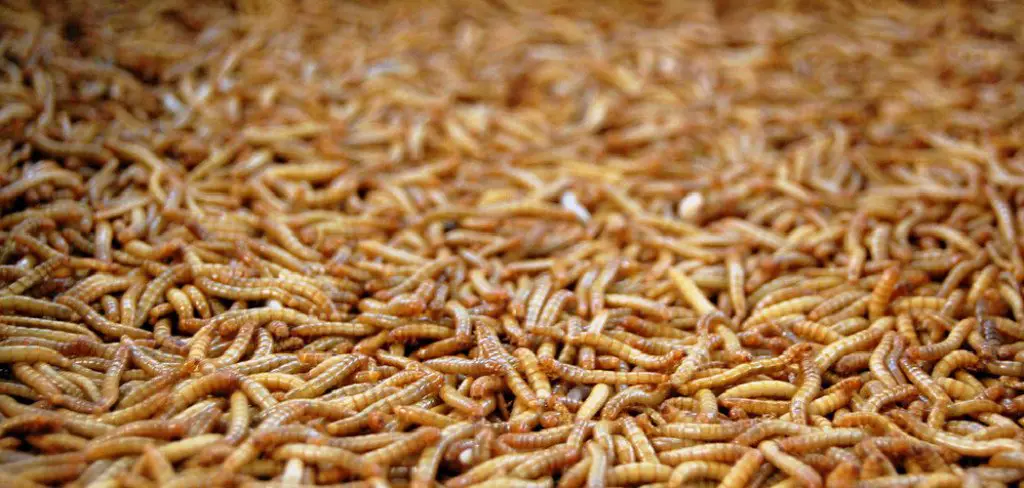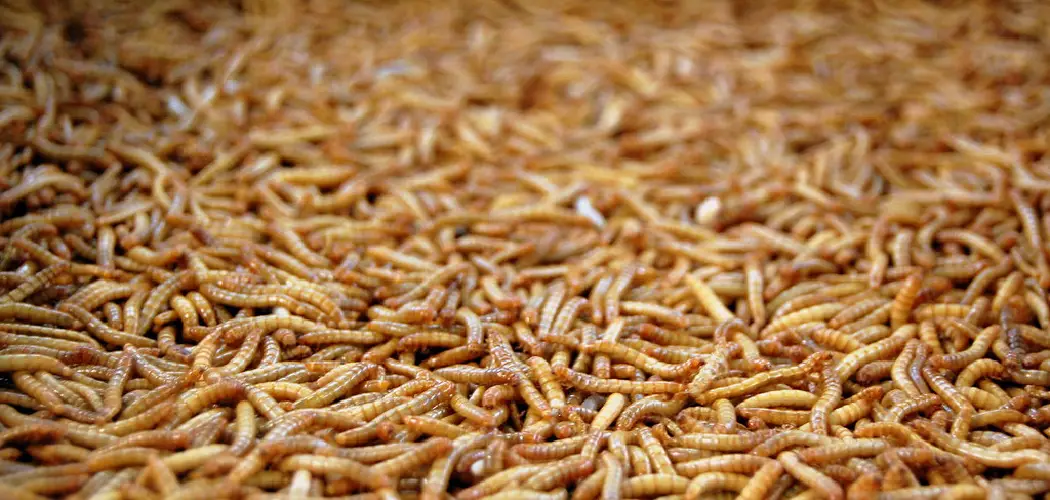Maggots are fly larvae that can be a real nuisance. They can invade your home and cause damage, or they can infest your garage and make it difficult to work in. If you have maggots in your garage, there are several steps you can take to get rid of them. Maggots are gross and can be a major problem, but thankfully there are ways to get rid of them.

It is important to know how to get rid of maggots in garage. In this blog post, we will discuss some methods for getting rid of maggots in your garage. We’ll also provide some tips on how to prevent maggots from forming in the first place. Let’s get started! By following these steps, you can get rid of maggots in your garage quickly and easily.
Summary: Maggots are a common problem in garages and other areas of the home due to their attraction to organic materials such as food scraps, pet waste, and decaying matter. To get rid of maggots effectively, it is important to remove all sources of food for them by properly disposing of garbage and other organic material regularly. Additionally, sealing any cracks and crevices in the walls and floors of your garage can help to prevent maggots from coming inside.
Tools You Will Need
- Insecticide
- Bait (e.g., sugar and water)
- Heat source (heat lamp or blow dryer)
- Cold source (ice packs or cold compress)
- Disinfectant
13 Easy Steps Guide on How to Get Rid of Maggots in Garage
Step 1: Identify the Source
The first step in getting rid of maggots in your garage is to identify the source of the infestation. Maggots are the larvae of flies and typically feed on decomposing organic matter. Look for rotting food, garbage, or animal carcasses in and around your garage that could be attracting flies and providing a breeding ground for maggots.
Step 2: Remove the Source
Once you have identified the source of the infestation, remove it from your garage immediately. Dispose of any rotting food, garbage, or animal carcasses in sealed plastic bags and place them in an outdoor trash bin with a tight-fitting lid. If the source of the infestation is not immediately apparent, thoroughly clean your garage, paying particular attention to areas where organic materials, such as food or pet waste, may have accumulated.
Step 3: Dispose of Maggots
Next, collect and dispose of any visible maggots. You can do this by using a broom and dustpan, a vacuum cleaner with a disposable bag, or by picking them up with disposable gloves. Place the collected maggots in a sealed plastic bag and dispose of them in an outdoor trash bin with a tight-fitting lid.
Step 4: Clean the Infested Area
Thoroughly clean the area where you found the maggots, using hot water and soap or a commercial cleaning solution. Pay particular attention to any cracks, crevices, or gaps where maggots may be hiding. Scrub the area with a brush, and then rinse with hot water. This will help remove any remaining maggots, eggs, and organic matter that could attract more flies.
Step 5: Apply Diatomaceous Earth or Insecticide
To help prevent future infestations, consider applying diatomaceous earth or a commercial insecticide to the affected area. Diatomaceous earth is a natural, non-toxic powder that can help kill maggots and other insects by damaging their exoskeletons. Alternatively, you can use a commercial insecticide specifically designed for maggots or flies, following the manufacturer’s instructions for application. Always take care to follow the safety guidelines on the product label, and use caution when applying insecticides around children or pets.
Step 6: Eliminate Moisture
Maggots thrive in damp, moist environments, so it’s important to eliminate any sources of excess moisture in your garage. Check for leaks or water damage, and make any necessary repairs to prevent water from accumulating. Ensure that your garage is well-ventilated, and consider using a dehumidifier to reduce humidity levels if necessary.
Step 7: Seal Potential Entry Points
Flies can lay eggs in your garage through small openings or cracks, so it’s crucial to seal any potential entry points. Inspect the exterior of your garage for gaps or cracks, and repair them using caulk or other appropriate materials. Make sure that your garage door is properly sealed when closed, and install weatherstripping around the door and windows if needed.
Step 8: Maintain Proper Garbage Disposal
Proper garbage disposal is essential for preventing maggot infestations in your garage. Always store garbage in sealed plastic bags and place them in an outdoor trash bin with a tight-fitting lid. Dispose of trash regularly, and clean your trash bins with hot water and soap or a commercial cleaning solution to remove any organic residue that could attract flies.
Step 9: Install Fly Traps
To help control the fly population around your garage, consider installing fly traps. There are several types of fly traps available, including sticky traps, electric traps, and baited traps. Place the traps near the garage, but not inside, to avoid attracting more flies into the space.
Step 10: Regular Cleaning and Maintenance
Regular cleaning and maintenance of your garage are essential for preventing future maggot infestations. Sweep and mop the floor regularly, and keep surfaces free of organic debris, such as food scraps, pet waste, or dead insects. Inspect your garage for signs of infestations regularly, taking note of any unusual odors or visible pests.
Step 11: Store Food Properly
If you store food in your garage, ensure that it is properly sealed in airtight containers. This will help prevent flies from being attracted to the food and laying eggs. Additionally, avoid storing perishable items in the garage, as they can spoil and attract pests.
Step 12: Monitor for Signs of Infestations
Regularly monitor your garage for signs of maggot infestations, such as the presence of adult flies, maggots, or an unpleasant odor. If you notice any of these signs, take immediate action to identify and remove the source of the infestation, following the steps outlined above.
Step 13: Seek Professional Help if Necessary
If you are unable to get rid of the maggots in your garage or if the infestation is particularly severe, consider seeking professional help. Pest control professionals have the knowledge, tools, and experience necessary to effectively eliminate maggot infestations and provide guidance on how to prevent future infestations.
By following these steps, you can effectively eliminate and prevent maggot infestations in your garage. Proper cleaning, maintenance, and disposal of organic materials are crucial for keeping flies and maggots at bay. Additionally, sealing potential entry points, eliminating moisture, and using fly traps can further reduce the risk of infestations. With consistent effort and vigilance, you can maintain a clean and maggot-free garage.
Frequently Asked Questions
How to Identify Where Maggots Are Coming From and Stop the Problem at Its Source?
Identifying the source of maggots can be an unpleasant task, but it’s important to do so to prevent a maggot infestation. The first step is to look for signs of fly activity around your home – this could include seeing live flies or finding dead ones.
If you’ve identified a spot where flies are gathering, it may be time to inspect any nearby food sources – like pet food bowls or unrefrigerated leftovers.
Once you’ve tracked down the source, removing any leftover food or debris and keeping surfaces clean will help you rid your house of maggots for good. It’s also helpful to practice good hygiene habits and dispose of trash in secure containers outside regularly. By taking these steps, you should be able to keep maggots from coming back into your home without fail.
How to Use Bait, Heat, or Cold to Get Rid of Maggots in Your Garage?
One of the more unpleasant chores associated with tidying up your garage is dealing with infestations of maggots. The most straightforward way to rid your garage of these pests is by using either heat, cold, or bait.
For heat, you can use boiling water to boil the maggots alive, though make sure that you are wearing protective gear and keep children and pets away from the area at all times.

Cold can also be used effectively – freezing temperatures will kill off any maggot infestation. Lastly, you can lure them away from their breeding grounds by using sweet-smelling bait such as fruit or honey to attract them out of hiding. Mindful application of these methods should help get your garage back in order!
Conclusion
You should now be able to get rid of maggots in your garage quickly and easily using one of the methods above. If you have maggots in your garage, don’t worry! You can get rid of them quickly and easily with a few simple household ingredients.
You should carefully determine how to get rid of maggots in garage. Just follow the steps outlined in this article and you’ll be maggot-free in no time. If you have any other tips or tricks on how to get rid of maggots, feel free to share them in the comments below. Thanks for reading!

